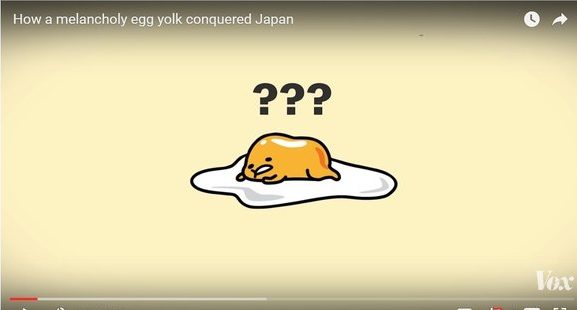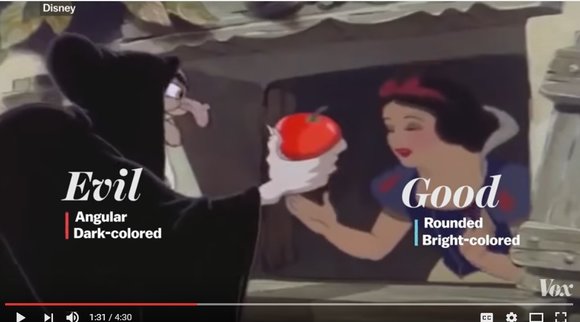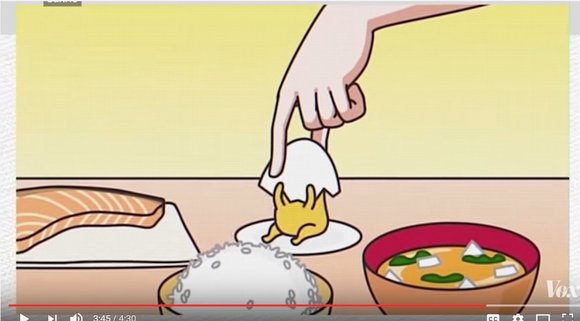
The team at Vox shed light onto the development and popularity of the lovable egg with a bum.
Sanrio is best-known as the company that’s been producing Hello Kitty merchandise since 1974 (along with merch for newer characters like Aggretsuko the office-worker red panda). One of Sanro’s most popular characters these days is Gudetama, a melancholy egg yolk.
In a recent video, Dion Lee and Alex Abad-Santos of Vox explain what Gudetama is, how it was developed, and possible reasons the eggy icon has become such a phenomenal hit.
Despite only coming in second place in a 2013 company-wide competition to find a new food-based character (rather bizarrely losing out to a salmon fillet, who’s now a star in her own right), Gudetama has gone on to become one of their most successful characters. But why do people relate to an amorphous sloth-like egg? To explain, Vox go on to try and explain the cultural differences between Western and Japanese definitions of “cuteness” by using Disney characters as a comparison. Although in doing this, I think they overegg the differences a bit much.
They then go on to explain the causes of Japan’s affinity for “kawaii” culture by linking it to an acceptance by Japan of the Potsdam Declaration at the end of World War II, and the sense of vulnerability that this engendered.
In recent years, Sanrio’s characters have evolved from the mouth-less “blank canvas” characters onto whom you can project your own feelings, like Hello Kitty, to characters with personalities we can relate to like Aggretsuko or Gudetama. In our stressful, modern existence the guys at Vox posit the question that maybe all we need is an “egg yolk with a little bum, who’s given up on life”.
While its form may be sunny-side up, Gudetama’s disposition is rather less so, but maybe Gudetama appeals because we’ve all had days when we wanted to take cover under a protective shell.
Source, images: YouTube/Vox




 Sanrio’s Gudetama is getting a Netflix series…that’s live-action??
Sanrio’s Gudetama is getting a Netflix series…that’s live-action?? Lazy Sanrio egg Gudetama opens new restaurant in Tokyo!
Lazy Sanrio egg Gudetama opens new restaurant in Tokyo! Gudetama the lazy egg shines — as stylish gold and platinum jewelry!
Gudetama the lazy egg shines — as stylish gold and platinum jewelry! Sanrio releases new character: Aggretsuko, the white-collar red panda with anger issues
Sanrio releases new character: Aggretsuko, the white-collar red panda with anger issues Sanrio terror — Horrifying “real-world Gudetama” appears in Japanese kitchen
Sanrio terror — Horrifying “real-world Gudetama” appears in Japanese kitchen Foreigner’s request for help in Tokyo makes us sad for the state of society
Foreigner’s request for help in Tokyo makes us sad for the state of society Red light district sushi restaurant in Tokyo shows us just how wrong we were about it
Red light district sushi restaurant in Tokyo shows us just how wrong we were about it McDonald’s new Happy Meals offer up cute and practical Sanrio lifestyle goods
McDonald’s new Happy Meals offer up cute and practical Sanrio lifestyle goods Hello Kitty isn’t a cat!? We called Sanrio to find out!
Hello Kitty isn’t a cat!? We called Sanrio to find out! New private rooms on Tokaido Shinkansen change the way we travel from Tokyo to Kyoto
New private rooms on Tokaido Shinkansen change the way we travel from Tokyo to Kyoto Historical figures get manga makeovers from artists of Spy x Family, My Hero Academia and more
Historical figures get manga makeovers from artists of Spy x Family, My Hero Academia and more Anime girl English teacher Ellen-sensei becomes VTuber/VVTUber and NFT
Anime girl English teacher Ellen-sensei becomes VTuber/VVTUber and NFT Japan’s massive matcha parfait weighs 6 kilos, contains hidden surprises for anyone who eats it
Japan’s massive matcha parfait weighs 6 kilos, contains hidden surprises for anyone who eats it McDonald’s Japan releases a pancake pie for new retro kissaten coffeeshop series
McDonald’s Japan releases a pancake pie for new retro kissaten coffeeshop series Japanese ramen restaurants under pressure from new yen banknotes
Japanese ramen restaurants under pressure from new yen banknotes All-you-can-drink Starbucks and amazing views part of Tokyo’s new 170 meter-high sky lounge
All-you-can-drink Starbucks and amazing views part of Tokyo’s new 170 meter-high sky lounge French Fries Bread in Tokyo’s Shibuya becomes a hit on social media
French Fries Bread in Tokyo’s Shibuya becomes a hit on social media Studio Ghibli releases new action figures featuring Nausicaä of the Valley of the Wind characters
Studio Ghibli releases new action figures featuring Nausicaä of the Valley of the Wind characters Studio Ghibli glasses cases let anime characters keep an eye on your spectacles
Studio Ghibli glasses cases let anime characters keep an eye on your spectacles Tokyo Tsukiji fish market site to be redeveloped with 50,000-seat stadium, hotel, shopping center
Tokyo Tsukiji fish market site to be redeveloped with 50,000-seat stadium, hotel, shopping center Beautiful Ghibli sealing wax kits let you create accessories and elegant letter decorations【Pics】
Beautiful Ghibli sealing wax kits let you create accessories and elegant letter decorations【Pics】 Studio Ghibli releases Kiki’s Delivery Service chocolate cake pouches in Japan
Studio Ghibli releases Kiki’s Delivery Service chocolate cake pouches in Japan New definition of “Japanese whiskey” goes into effect to prevent fakes from fooling overseas buyers
New definition of “Japanese whiskey” goes into effect to prevent fakes from fooling overseas buyers Our Japanese reporter visits Costco in the U.S., finds super American and very Japanese things
Our Japanese reporter visits Costco in the U.S., finds super American and very Japanese things Studio Ghibli unveils Mother’s Day gift set that captures the love in My Neighbour Totoro
Studio Ghibli unveils Mother’s Day gift set that captures the love in My Neighbour Totoro New Japanese KitKat flavour stars Sanrio characters, including Hello Kitty
New Japanese KitKat flavour stars Sanrio characters, including Hello Kitty More foreign tourists than ever before in history visited Japan last month
More foreign tourists than ever before in history visited Japan last month New Pokémon cakes let you eat your way through Pikachu and all the Eevee evolutions
New Pokémon cakes let you eat your way through Pikachu and all the Eevee evolutions Sales of Japan’s most convenient train ticket/shopping payment cards suspended indefinitely
Sales of Japan’s most convenient train ticket/shopping payment cards suspended indefinitely Sold-out Studio Ghibli desktop humidifiers are back so Totoro can help you through the dry season
Sold-out Studio Ghibli desktop humidifiers are back so Totoro can help you through the dry season Japanese government to make first change to romanization spelling rules since the 1950s
Japanese government to make first change to romanization spelling rules since the 1950s Ghibli founders Toshio Suzuki and Hayao Miyazaki contribute to Japanese whisky Totoro label design
Ghibli founders Toshio Suzuki and Hayao Miyazaki contribute to Japanese whisky Totoro label design Doraemon found buried at sea as scene from 1993 anime becomes real life【Photos】
Doraemon found buried at sea as scene from 1993 anime becomes real life【Photos】 Tokyo’s most famous Starbucks is closed
Tokyo’s most famous Starbucks is closed One Piece characters’ nationalities revealed, but fans have mixed opinions
One Piece characters’ nationalities revealed, but fans have mixed opinions We asked a Uniqlo employee what four things we should buy and their suggestions didn’t disappoint
We asked a Uniqlo employee what four things we should buy and their suggestions didn’t disappoint Princesses, fruits, and blacksmiths: Study reveals the 30 most unusual family names in Japan
Princesses, fruits, and blacksmiths: Study reveals the 30 most unusual family names in Japan Sanro’s lazy egg Gudetama now has its own maid cafe in Tokyo’s Akihabara
Sanro’s lazy egg Gudetama now has its own maid cafe in Tokyo’s Akihabara Sanrio’s lazy egg character appears on menu items at new Gudetama Cafe in Osaka
Sanrio’s lazy egg character appears on menu items at new Gudetama Cafe in Osaka Meet the most unmotivated Sanrio character ever — Gudetama, the lazy egg!
Meet the most unmotivated Sanrio character ever — Gudetama, the lazy egg! Are Women-Only train cars illegal in Japan?
Are Women-Only train cars illegal in Japan? Sanrio’s laziest character gets a hand from its surliest as Bad Badtz-Maru joins Gudetama Cafe
Sanrio’s laziest character gets a hand from its surliest as Bad Badtz-Maru joins Gudetama Cafe Eat these new desserts and celebrate the weirdest Easter ever with the lazy egg Gudetama
Eat these new desserts and celebrate the weirdest Easter ever with the lazy egg Gudetama Gudetama the lazy egg now being served as actual dish, looks absolutely adorable!
Gudetama the lazy egg now being served as actual dish, looks absolutely adorable! Video of lazy egg Gudetama cleaning up goes viral on Twitter【Video】
Video of lazy egg Gudetama cleaning up goes viral on Twitter【Video】 McDonald’s Japan presents newest McFlurry dessert — in a mystery Gudetama flavor!
McDonald’s Japan presents newest McFlurry dessert — in a mystery Gudetama flavor! Gudetama the lazy egg is adorable … even as he poops and vomits! 【Video】
Gudetama the lazy egg is adorable … even as he poops and vomits! 【Video】 Sanrio’s Gudetama 1st anime short streamed
Sanrio’s Gudetama 1st anime short streamed Hornets: The perfect pet for people living in Japan?
Hornets: The perfect pet for people living in Japan? The 2023 Sanrio character popularity ranking results revealed
The 2023 Sanrio character popularity ranking results revealed Sanrio amusement park opening first new attraction in six years: an ultra-cute meet-and-greet house
Sanrio amusement park opening first new attraction in six years: an ultra-cute meet-and-greet house
Leave a Reply